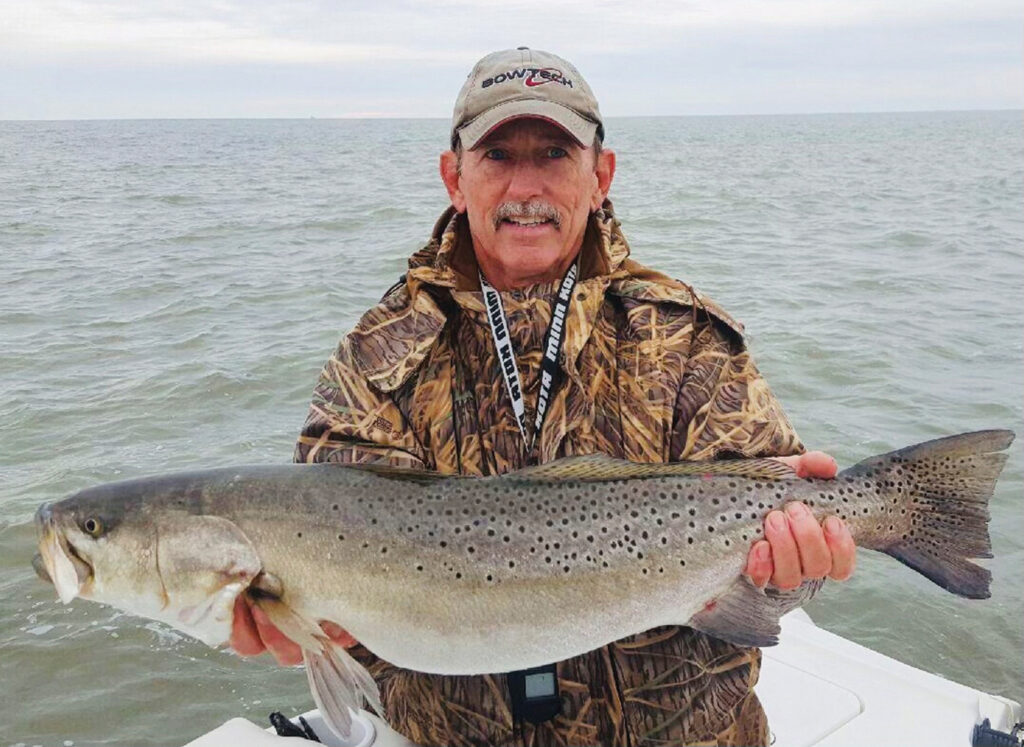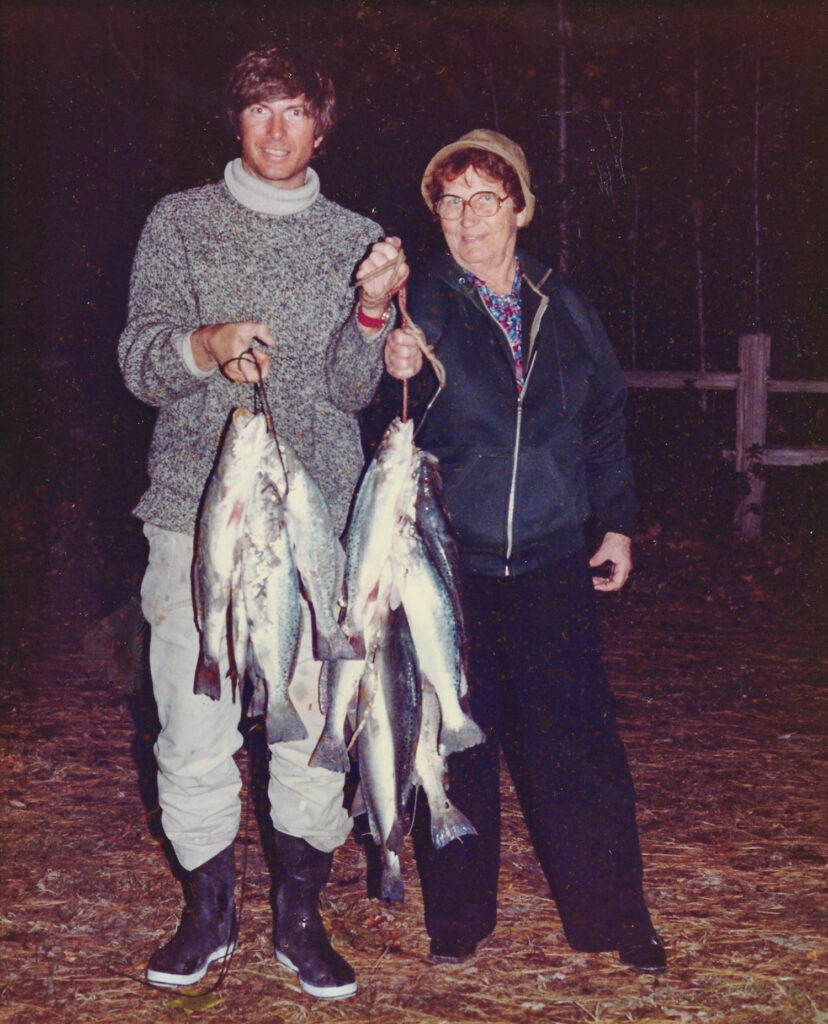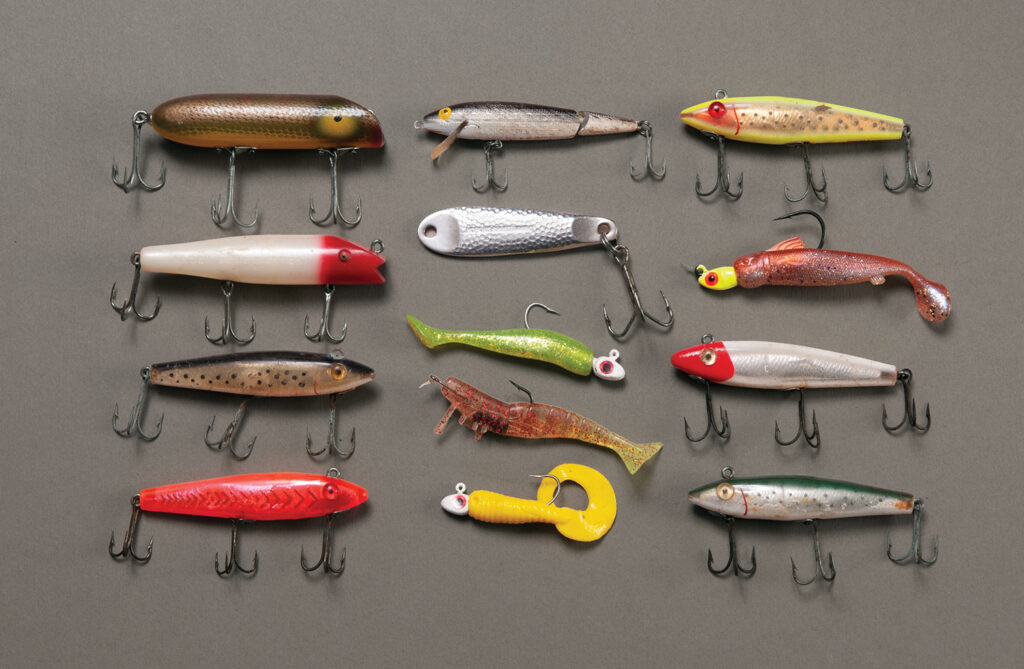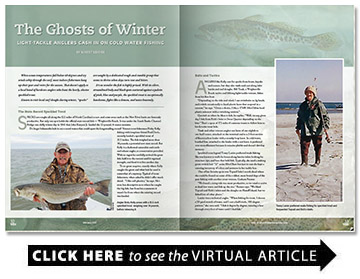The Ghosts of Winter
Light-tackle anglers cash in on cold water fishing
BY Robert Rehder

When ocean temperatures fall below 60 degrees and icy winds whip through the surf, most inshore fishermen hang up their gear and retire for the season. That doesn’t apply to a local band of hardcore anglers who hunt the lovely, elusive speckled trout.
Known to visit local surf sloughs during winter, “specks” are sought by a dedicated rough-and-tumble group that seems to thrive when days turn raw and bitter.
It’s no wonder the fish is highly prized. With its silver, streamlined body and black spots scattered against a palette of pink, blue and purple, the speckled trout is exceptionally handsome, fights like a demon, and tastes heavenly.
The State-Record Speckled Trout
Specks are caught all along the 322 miles of North Carolina’s coast, and some areas such as the New River basin are famously productive. But only one spot holds the official state-record fish — Wrightsville Beach. It was under the South Banks Channel Bridge one chilly winter day in 1961 that John Kenyon Jr. landed the 12-pound, 4-ounce monster.
Do larger behemoths lurk in our coastal waters that could upset the longstanding record? Veteran trout fisherman Ricky Kelly, fishing with longtime friend Fred Davis, recently landed a speckled trout of 31.5 inches. The fish weighed more than 14 pounds, a potential new state record. But Kelly is a dedicated naturalist and catch-and-release angler, so conservation prevailed. With no regret he carefully revived the great fish, held it in the current until it regained strength, and freed it to live another day.
To no great surprise, exactly where Kelly caught the giant and what bait he used is somewhat of a mystery. Typical of trout fishermen, when asked he didn’t offer much detail. “I like soft plastics,” he says. He’s even less descriptive as to where he caught the big fish, but from his comments it wasn’t far from where the existing record was landed.
Baits and Tactics
Anglers like Kelly cast for specks from boats, kayaks and canoes, but they also wade and cast along inlet banks and surf sloughs. Bill Trask, a Wrightsville Beach native and lifelong light-tackle veteran, fishes from his flats boat.
“Depending on the tide and wind, I use swimbaits on jig heads, and switch occasionally to hard plastic lures that suspend in a current,” he says. “Given a choice, I like a 17MR MirrOdine hard plastic minnow with a twitching retrieve.”
Queried on where he likes to fish, he replies, “Well, on any given day I fish from Rich’s Inlet to Swan Quarter depending on the bite.” That’s a span of 173 miles if someone wants to follow him to his favorite trout hole.
Trask and other veteran anglers use lures of one-eighth to one-half ounce, attached on the terminal end to a 3-foot section of fluorocarbon leader with a nonslip loop knot. In cold water, braided line, attached to the leader with a uni knot, is preferred over monofilament because it remains pliable and doesn’t develop memory.
Speckled trout legend Toney Lanier preferred wade fishing. She was known to walk for hours along barrier inlets looking for structure rips, and bars that held fish. Typically, she used a sinking green twitch bait “52” series MirrOlure but just in case she kept a running inventory of colors and patterns in her tackle box.
One of her favorite spots was Topsail Inlet’s north shoal where she could be found on some of the coldest, most brutal days of the year fishing with another trout veteran, Graham Farmer.

“We found a rising tide was most productive, so we tried to arrive at dead low water and fish up the rise,” Farmer says. “We liked Topsail and Rich’s inlets and the sloughs on Hutaff Island, but we fished lots of other places.”
Lanier was a technical angler. “When fishing for trout, I choose a 50-yard stretch of water, and I cast a half-circle, 180-degree pattern,” she once said. “I fish it degree by degree, running a lure through every foot of water until I find fish.”
Specks like clean, cold, moving water and can be found lurking in backwater flats, feeding through coastal creeks and inlets, and sunning in surf sloughs. Conditions can change quickly and vary from quiet and peaceful to rough and complicated.
“Speckled trout fishing can be finicky,” Lanier said. “And sometimes even when you find a school they simply don’t bite. I was fishing in the surf on Topsail Beach one winter morning and the water was so clear I could see a big school of trout sunning in the slough in front of me. I tried several lures, but the fish just would not strike. Finally, I chose the right color — a yellow-green pattern (MirrOlure 7M Chartreuse) — and then just like that the bite was on!”
Gear for Speckled Trout
Gear is always an individual preference, but experienced trout fishermen consistently use specific types. Most choose a 6-to-7-foot, fast action, one piece graphite spinning rod, such as a Shimano Teramar. Many spinning reels like the Penn Battle III work well but should comfortably hold 6-to-12-pound test braid line and have a smooth, reliable drag.
You get what you pay for in saltwater equipment and a malfunction can ruin an otherwise rewarding trip. Fishing in cold weather can be an exhilarating pleasure or a real challenge — quality gear can make the difference.
Whether using soft plastics such as the Berkley Gulp or hard plastics like the MirrOdine, realistic action is critical and the idea is to present a lure that swims flawlessly and offers the most lifelike presentation.
Some fishermen choose monofilament and some choose braid, but with either choice repeated casting in windy conditions occasionally produces a fouled line known as a wind knot or bird’s nest. It’s always advisable to pack pliers equipped with a line cutter designed for braid to quickly get back in the game.

With the onset of winter, anglers are setting the hook on heavy specks, maybe even the new state record. There are wild places waiting along our coast that hold these remarkable fish. Inshore and nearshore waters from Bald Head Island to New River Inlet offer some of the coast’s finest speckled trout fishing. Veteran anglers look for rips, creek oxbows and switchbacks around inlets, coastal bays and estuaries.
When water temperatures fall, live bait becomes scarce and the time is right to ambush specks with plastics. Be prepared with a wide variety of lures to include twitch baits, soft plastics and suspending crank baits, because productive combinations can vary day to day.
Finding fish is a skill borne of experience, so anyone not familiar with local waters will certainly benefit from the expertise of an experienced guide. Professional guides are on the water all year and know how to put you in the fish.
If You Catch a Tagged Fish
Fortunate anglers sometimes catch a speckled trout with a tag. Look for a thin, yellow, numbered tag trailing from the underside of the fish’s belly. Through the speckled trout tagging program, the North Carolina Division of Marine Fisheries offers rewards up to $100 for the return of trout tags. Visit their website at www.ncdmf.net for details. They also offer a citation for all speckled trout heavier than 5 pounds if weighed and registered at an official weigh station.
In North Carolina, there is a creel limit of four speckled trout and a length limit no less than 14 inches. Fishing in coastal waters requires a Coastal Recreational Fishing License offered on the N.C. Wildlife Resources Commission website or through area bait, tackle and sporting goods shops.

can i share this article, it is awesome